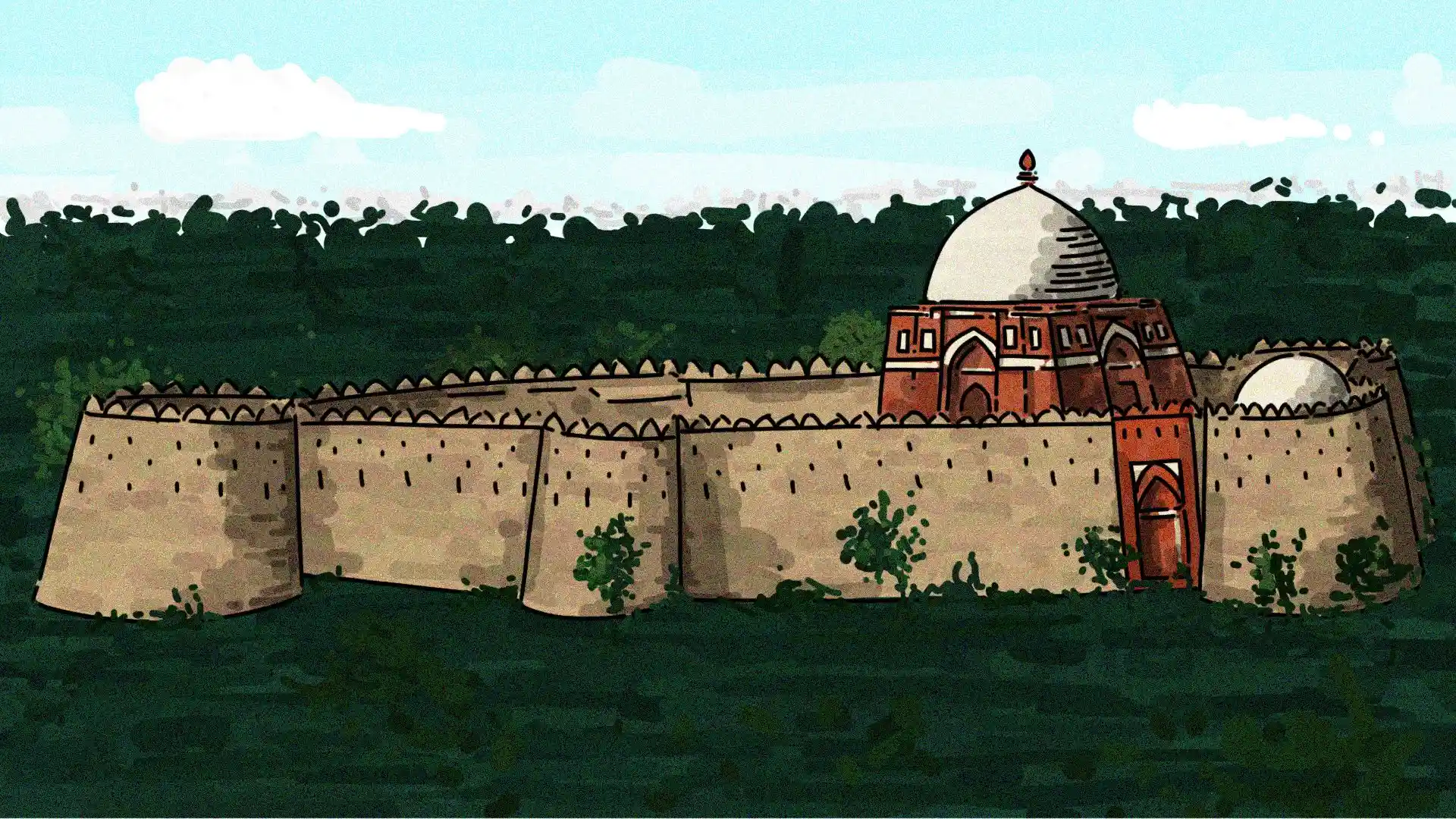DELHI The City That Would Not Die: Tughlaqabad
The story of Delhi, the capital of India, is not just the story of one city, but of at least eight (recorded and recognised) capital cities that shifted locations through the ages, finally settling down at the current location as the ninth capital of India. It has been the site of a succession of seats of empires, whose remains can still be seen in the current city of Delhi.

Tughlaqabad, Illustrated by Riya Kumari: Visual Storyteller at ThisDay.
Sultan Alauddin Khilji died in 1316 and thereafter the Sultanate experienced a succession of assassinations. Malik Kafur was the Sultan’s favourite general, who had led numerous military campaigns to expand the sultanate. Since he was present at the time of Alauddin’s death, he took the opportunity of controlling the throne by appointing the Sultan’s six-year-old son Shihabuddin Omar as a puppet king.
This connivance did not last long and Malik Kafur was killed by Alauddin’s former bodyguards. Mubarak Shah, the Sultan’s teenage son took over the throne by killing his younger brother Shihabuddin. After ruling barely for not even four years, Mubarak was murdered by his own friend, his army chief Khusro Khan. This was in 1320.
However, Khusro lacked the support of Muslim nobles and aristocrats, who invited Ghazi Malik to lead a coup and remove Khusro Khan. Sultan Alauddin had trusted Ghazi’s martial skills and had appointed him the governor of Multan and Dipalpur (both in present day Pakistan) located in the frontier region of Delhi Sultanate.
Before joining the service of the Khiljis, and even after that for some time, Ghazi had worked as a menial servant and had risen in ranks by his hard work and dedication towards learning martial skills.
Ghazi Malik was successful in killing Khusro Khan and assuming power. Thereafter, he renamed himself as Ghiyasuddin Tughlaq, and so began the Tughlaq dynasty. He chose to build his capital 5 km away from Qila Rai Pithora, on a hillock. The grand impregnable fortified city thus constructed was called Tughlaqabad. This was in 1321.
The semi-hexagonal fortified city of Tughlaqabad, spread over 12.5 km, is situated in the southern outskirts of the current city of Delhi, neighbouring the Asola wildlife sanctuary. The remarkable massive stone fortifications can still be seen in its desolate ruins, a large part of which have been taken over by encroachers. The 10-15 metres high sloping rubble filled walls, a typical feature of the monuments of Tughlaq dynasty, were topped with parapets and strengthened by circular bastions, an impressive sight even today as one drives along the Mehrauli-Badarpur road.
The fortified Tughlaqabad comprised of a large area dedicated to rows of houses for people serving the Sultan, in between its 52 gates, of which only 13 gates remain today amongst the scattered ruins of the houses. Within the fort ruins is a tall, impressive, three-gated citadel and a palace whose remains in the form of large halls and underground passageways still exist today. The fortified city had 7 rainwater tanks, which no longer exist, but the relics of underground chambers, baths and marketplace are still visible.
Since the fortified city was built on a rocky terrain, it was not easy to obtain water. This was one of the main reasons why people preferred to stay in the earlier capital, making the fort a kind of detached complex for the Sultan’s residence, for his personal retinue and troops. The citadel however was connected to the old city through underground passages.
A vast reservoir was made to the south of Tughlaqabad, outside the fort. On a small island in the middle of this man-made lake, Tughlaq made his Dar-ul-Aman or abode of peace, which also became his own burial site. The lake does not exist anymore, though the white-domed red-walled mausoleum of Ghiyasuddin Tughlaq still stands tall in quiet dignity, nestling within it the graves of Tughlaq, his wife and his favourite son Mahmud. The well-preserved mausoleum remains connected to the main fort by an elevated causeway, that is still functional today. The tomb can be seen opposite the current main entry gate of Tughlaqabad fort, near Badarpur border of Delhi-Faridabad.
The main stream that fed the man-made lake, still flows, but it has Mehrauli’s sewage in it. In fact, all the drains of Delhi were once tributaries of river Yamuna, which has dramatically altered its course since then.
In the process of expanding his rule in the east, Ghiyasuddin Tughlaq placed Tughlaqabad under the control of his son Muhammad-bin-Tughlaq and led his army to Bengal. After succeeding in his mission, Tughlaq, his wife and son Mahmud returned to their capital. According to historical accounts of that time, Muhammad engineered to kill his father inside a flimsily built wooden rest house, a few kilometres short of Tughlaqabad. He succeeded. This was in 1325.
A legend associated with Tughlaqabad says that the city was cursed by Khwaja Nizamuddin Auliya whose work of building a baoli (stepwell) while the city was being built, was stalled by Ghiyasuddin. The curse was that the fort and the city would either be deserted or be inhabited by nomads – Ya rahe ujjar, ya base gujjar. People believe the curse to be the reason behind its desolate state.
When you visit the southern outskirts of Delhi, do pause to look at Bari Manzil between Kalu Sarai and Begampur village, Khirkee mosque and Chirag-i-Dilli’s dargah on Malviya Nagar-Kalkaji road to savour the beauty of Tughlaq architecture. Who knows you may even stumble upon some old caravanserai or madrasa hiding some more forgotten stories of centuries gone by…
This is a very brief account of the third city of Delhi… you can discover much more by walking through the above mentioned areas leisurely.


